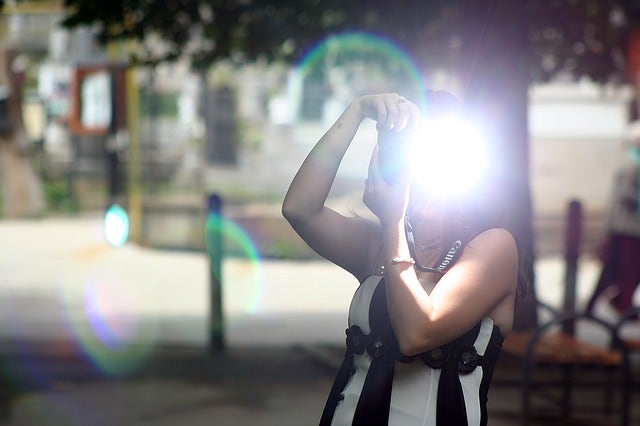So many photographers make the mistake of thinking that they should only use flash to illuminate dark scenes.
It’s true that flash is usually best kept to a minimum if you can use alternative, natural sources of light. But you’ll also limit your photography opportunities if you restrict flash usage to dark scenes.
Flash gives you more control over your photos. You can redirect it, soften it, mix it, reflect it, and even colour it. Imagine the creative shots you can achieve!
You can use flash any number of ways, either to complement existing light sources or to create new effects in different types of photography.
One way to stand out as a photographer is to learn how to master flash in a wide variety of scenarios. Knowing when to use it - and when to leave it alone - is an important step to becoming a more successful photographer.

Use Flash Photography...
To Add Drama
Say you’ve got a stunning scene with storm clouds in the distance and a backlit subject, such as a building, in the foreground. It’s the perfect setup, but can be difficult to shoot.
Focus on the clouds and you’ll end up getting the building in shadow. Focus on the building and you’ll lose all the detail in your clouds.
The best photograph will naturally be one that encapsulates the drama of the scene - and for that, you need contrast.
In this scenario, it’s best to underexpose your image by one or two stops and add a flash to illuminate the pier.
To Stop or Capture Motion
It’s ironic that you can use flash both to still your subject and capture its motion. But you can create some incredible effects when shooting movement in darker scenes.
Your shutter speed isn’t nearly as fast as your flash unit, especially if you’re using a speedlight or larger flash. So if you’re struggling to capture motion but you need to keep your aperture narrow, flash is the obvious way to go.
Alternatively, you can get really creative by capturing the blur of movement while freezing your subject. To achieve this, slow down your shutter speed to record a longer exposure, then use the flash. This will capture the motion in your frame before capturing a sharp still of the object.
To Capture Unique, Creative Shots
There are plenty of ways to use flash that will differentiate your photographs from all the others out there.
But one way is to combine your flash with colour gels, such as Magmod's Standard Gels. This can put halos of different colours around your subject wherever the flash lands and will make your photos truly original.
Flash in Macro Photography
Close-up photography can be a tricky one because you often lack the depth of field needed for a three-dimensional effect.
In many cases, you just won’t get enough ambient light to use the smaller aperture needed. When you use smaller apertures, you need slower shutter speeds, which doesn’t help if you’re trying to capture movement.
This is where your flash comes to the rescue. It illuminates your subject, providing greater depth of field and allowing a faster shutter speed.
Using flash can also help boost colour and contrast, helping to enliven your image.
Flash in Portrait Photography
There’s no worse light than one that is directed straight into your subject’s face. It can be harsh, cold, and unflattering. Not to mention, it can cause your subject to squint or blink.
Most portrait photographers redirect and soften their flash to create shadow and dimension on their subject’s face. They usually do this by bouncing the flash light off softer, reflective surfaces.
You can use your surroundings to do this; a white wall or ceiling works well. Many photographers will also use a white reflector. It will give the light a softer and more natural appearance.
For the more serious photographer, you might want to use a wide diffuser and a “catchcard”. With these tools, you can add some fill-light on your subject’s faces while still sending most of it onto the ceiling to bounce.
This technique emulates window lighting, creating shadows on the face similar to those you’ll achieve with professional studio lighting.
Just a little bit of frontal reflection like this will fill shaded areas, such as eye sockets and under the chin.
Using Off-Camera Flash in Portraits
In many cases, the best way to use your flashgun is off camera. This means the flash is physically disconnected from your camera’s hot-shoe.
The advantage of off camera flash is that you can change the direction, distance, and intensity of the flash, getting greater control and giving your image more natural lighting.
Having an off-camera flash also helps you separate your subject from the background, giving the whole image a more three-dimensional feel. It also helps you enhance the colour of your surroundings, especially if you’re shooting with dark shadows.
In a more complicated setup, you might even use more than one flashgun from multiple sides. For example, you might have a flash behind your subject as a rim light and then bounce a single flash off an umbrella to create a better image.
Using Flash to Change the Light Quality
There may be times when you love the particular way the natural light plays on the background elements in your shot, yet don’t like its effect on your subject.
In these circumstances, you can use flash to subtly soften or smooth out the existing light on your subject. The best way to do this is to project the flash into a softbox directed at your model.
There are plenty of ways to use flash to create different effects in your photographs or to entirely transform your images for the better. If you're looking for speedlites, flashguns, or other accessories to improve your photography, check out our range of lighting accessories online today!
